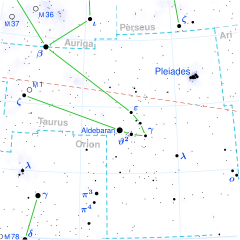
| |
| Observation data Epoch J2000.0 Equinox J2000.0 (ICRS) | |
|---|---|
| Constellation | Taurus |
| Right ascension | 04 27 17.4508 |
| Declination | +22° 59′ 46.778″ |
| Apparent magnitude (V) | 5.514 |
| Characteristics | |
| Evolutionary stage | main sequence |
| Spectral type | B7V |
| U−B color index | −0.48 |
| B−V color index | −0.10 |
| Astrometry | |
| Radial velocity (Rv) | 32.2±1.1 km/s |
| Proper motion (μ) | RA: −1.409 mas/yr Dec.: −13.722 mas/yr |
| Parallax (π) | 7.9390 ± 0.398 mas |
| Distance | 410 ± 20 ly (126 ± 6 pc) |
| Absolute magnitude (MV) | +0.21 |
| Details | |
| Mass | 3.47 M☉ |
| Radius | 2.8 R☉ |
| Luminosity | 185 L☉ |
| Surface gravity (log g) | 3.97 cgs |
| Temperature | 12,689 K |
| Rotational velocity (v sin i) | 115 km/s |
| Age | 38 Myr |
| Other designations | |
| υ Tau, 72 Tauri, BD+22°699, HD 28149, HIP 20789, HR 1399 | |
| Database references | |
| SIMBAD | data |
72 Tauri (abbreviated 72 Tau) is a possible binary star in the zodiac constellation of Taurus. It is faintly visible to the naked eye with an apparent visual magnitude of +5.5, although only 0.29° from the brighter υ Tauri. Based upon an annual parallax shift of 7.9 mas seen from Earth, it is around 410 light years from the Sun.
Properties
72 Tauri is a B-type main sequence star with a stellar classification of B7V. With a mass of 3.48 M☉ and an estimated age of 38 million years, it is 2.8 times the size of the Sun and 185 times its luminosity.
Occasionally this star system is given the Bayer designation υ Tauri with υ Tauri, which is separated from it by 0.29° in the sky. υ Tauri is a foreground star, the two are unrelated, and although 72 Tauri lies near the Hyades open cluster, it is much further away.
72 Tauri lies near the ecliptic and can be occulted by the moon. Observations of an occultation in 1985 showed that it was a binary star with the two components separated by 0.1″. There has been no confirmation of this finding and other sources list the star as single.
References
- ^ Vallenari, A.; et al. (Gaia collaboration) (2023). "Gaia Data Release 3. Summary of the content and survey properties". Astronomy and Astrophysics. 674: A1. arXiv:2208.00211. Bibcode:2023A&A...674A...1G. doi:10.1051/0004-6361/202243940. S2CID 244398875. Gaia DR3 record for this source at VizieR.
- Høg, E.; et al. (2000). "The Tycho-2 catalogue of the 2.5 million brightest stars". Astronomy and Astrophysics. 355: L27 – L30. Bibcode:2000A&A...355L..27H.
- ^ Mooley, Kunal; et al. (July 2013). "B- and A-type Stars in the Taurus-Auriga Star-forming Region". The Astrophysical Journal. 771 (2): 24. arXiv:1306.0598. Bibcode:2013ApJ...771..110M. doi:10.1088/0004-637X/771/2/110. S2CID 2176170. 110.
- ^ Hoffleit, D.; Jaschek, C. (1991). The Bright Star Catalogue. New Haven: Yale University Observatory. Bibcode:1991bsc..book.....H.
- Gontcharov, G. A. (November 2006). "Pulkovo Compilation of Radial Velocities for 35 495 Hipparcos stars in a common system". Astronomy Letters. 32 (11): 759–771. arXiv:1606.08053. Bibcode:2006AstL...32..759G. doi:10.1134/S1063773706110065. ISSN 1063-7737. S2CID 119231169.
- Anderson, E.; Francis, Ch. (2012). "XHIP: An extended hipparcos compilation". Astronomy Letters. 38 (5): 331. arXiv:1108.4971. Bibcode:2012AstL...38..331A. doi:10.1134/S1063773712050015. S2CID 119257644.
- Freire Ferrero, R.; et al. (February 2012). "High Ionization Species in the Nearby Interstellar Medium from an Exhaustive Analysis of the IUE INES Database". The Astronomical Journal. 143 (2): 38. Bibcode:2012AJ....143...28F. doi:10.1088/0004-6256/143/2/28. 28.
- ^ Gullikson, Kevin; Kraus, Adam; Dodson-Robinson, Sarah (25 July 2016). "The Close Companion Mass-ratio Distribution of Intermediate-mass Stars". The Astronomical Journal. 152 (2): 40. arXiv:1604.06456. Bibcode:2016AJ....152...40G. doi:10.3847/0004-6256/152/2/40. eISSN 1538-3881.
- "72 Tau". SIMBAD. Centre de données astronomiques de Strasbourg. Retrieved 2017-08-05.
- Kostjuk, N. D. (2004). "VizieR Online Data Catalog: HD-DM-GC-HR-HIP-Bayer-Flamsteed Cross Index (Kostjuk, 2002)". VizieR On-line Data Catalog: IV/27A. Originally Published in: Institute of Astronomy of Russian Academy of Sciences (2002). 4027. Bibcode:2004yCat.4027....0K.
- Vallenari, A.; et al. (Gaia collaboration) (2023). "Gaia Data Release 3. Summary of the content and survey properties". Astronomy and Astrophysics. 674: A1. arXiv:2208.00211. Bibcode:2023A&A...674A...1G. doi:10.1051/0004-6361/202243940. S2CID 244398875. Gaia DR3 record for this source at VizieR.
- Qian, B. -C; Zhu, G. -L.; Fan, Q. -Y. (1987). "The measurements of stellar angular diameter by photoelectric observation of lunar occultation". Acta Astronomica Sinica. 28: 45. Bibcode:1987AcASn..28...39Q.
- Eggleton, P. P.; Tokovinin, A. A. (September 2008). "A catalogue of multiplicity among bright stellar systems". Monthly Notices of the Royal Astronomical Society. 389 (2): 869–879. arXiv:0806.2878. Bibcode:2008MNRAS.389..869E. doi:10.1111/j.1365-2966.2008.13596.x. S2CID 14878976.